The feast of the Virgin Mary and Our Lady of the Assumption is also the memorial day of the Virgin Mary, patron of the country (Patrona Hungariae), which is celebrated in Esztergom on August 15. But the veneration of St. Stephen's tradition also lives on in the cathedral, in the celebration of St. Adalbert's Memorial Day, which takes place every year on April 23.
The first cathedral, already standing around 1010, was supposed to commemorate King Stephen's patron, St. Adalbert, bishop of Prague, who baptized King Stephen, just over a decade after his martyrdom. The twelfth-century reconstruction of the main cathedral dedicated to Saint Adalbert, in medieval sources also called as the beautiful church, was a significant monument from the point of view of this historical tradition with the ornate doorway opening from the western vestibule, fragments of which can be seen today in the Esztergom Castle Museum of the Hungarian National Museum. In the central part of the Porta Speciosa, in the arch field, the scene was shown as part of a complex creative program, in which King St. Stephen offers his kingdom to the protection of the Virgin Mary, who is sitting on the throne and holding her child in her lap, in the presence of Saint Adalbert. The veneration of the Blessed Virgin and Saint Adalbert was manifested at its second consecration two hundred and fifty years later, in 1453, and is still manifested today in the depictions of the main cathedral built in the 19th century. The inscription on the dome floating above the square in the "heart" of the church commemorates the joyful ascension of the Virgin Mary: Assumpta est Maria in Coelum Gaudent Angeli (Mary was taken up into heaven, angels rejoice). The main altarpiece, by Michelangelo Grigoletti, depicts the Ascension of Mary, but also the Blessed Virgin appears as patron of Hungary in the depiction completed by Grigoletti's relative Napoleone Nani following Grigoletti's composition after her unfortunate death. (St. Stephen offers the kingdom to the Virgin Mary) The feast of the of the Assumtion of Mary is also the memorial day of the Virgin Mary, patron of the country (Patrona Hungariae), which is celebrated in Esztergom on August 15. But the veneration of St. Stephen's tradition also lives on in the cathedral, in the celebration of St. Adalbert's Memorial Day, which takes place every year on April 23.
Winter-chapell
The winter-chapel is the heated part of the Cathedral, where during the cold season the Chapter conducts its daily worship. One of the main decorations of the chapel is the large altar of the Holy Cross.

Crucifix with bronze corpus 50 cm, the cross is made of copper, 180 cm high.
Statue of the Virgin Mary and St. John the Apostle: copper plate, 60cm
The main altar is made of wood, on which the gilded wooden statues of St. Adalbert, bishop and St. Stephen stand.
King St. Stephen holds the scepter and the orb.
Saint Adalbert in full episcopal ornament, holding in his hand a pastoral staff and spear made of metal: a symbol of episcopal and martyrdom.
Next to the altar are two glass coffins with reliquaries.
Head and bone relics of St. Clement and St. Boniface Martyr from the Roman catacombs.
In 1933, under the parish priestship of Kálmán Jeszenszky, Justinian Serédi and the General Chapter agreed that "the movable small altar of the Cathedral's winter chapel, which until now bore the title of the Virgin Mary, should also bear the names of Saint Peter and Saint Lucy".

Silver-framed image of St. Peter. 35×40cm. Silver-framed image of St. Lucia. 35×40cm.
The angel leads St. Peter out of prison. Suddenly, the chained prisoner had a light and an angel appeared. "Get up quick!" The angel said. "Put on your heels and robe."
Saint Lucia suffered martyrdom in Syracuse in 304 AD. She is the patron saint of people suffering from eye diseases and blindness (the name Lucia comes from lux = light), repentant street women. Her feast day is December 13.
Her attribute: in his hand is a bowl with two eyes on it and the palm of martyrdom.
Decorative paintings of the chapel
In 1933, Gábor Magasi Németh painted the basilica's winter chapel on behalf of Antal Lepold. He was told to take the two beatified ones of Esztergom; Özséb; the founder of the Pauline Order and Márk Kőrössi, one of the martyrs of Kassa. He was also told to pint the Chapter in various functions, as well as the canons, teachers of theology and also as head of the court of the Church. In addition, he is to paint on the ceiling the old picture that III Béla placed in marble mosaics above the decorative gate of the destroyed cathedral of Esztergom.
Finally, he is to paint two pictures of Mary, the one in the Bakócz chapel, the Mary of Trnava, and the smaller and larger stamp of the Chapter. Nine independent murals and rich neo-baroque ornamental techniques are al secco, i.e. a work painted afterwards on a dry wall.

On the ceiling, on an area divided by appropriate decorations, he painted the offer of the land for Mary in a concave area 4 meters wide and 3 meters long. The six-tiered throne rises on a golden mosaic pedestal, on which the Virgin Mary sits in a blue dress and a red robe, holding the baby Jesus on her right knee with both hands. The Hungarian flag lies on the steps of the throne and a harmless putto holds the coat of arms of Hungary with an oval shield. This image is the middle element of the large composition.
To the left of the Virgin, in the second aisle, stands St. Stephen with a black beard, in a purple dress reaching down to the ankles, with a green-blue coronation mantle whose lining is dark yellow. With his right hand, St. Stephen holds out the Hungarian royal scepter to Mary, who is looking at him. His lips open to speak: Accept the government of my country. Next to the king kneels an angel dressed in green, holding the holy crown on a crimson cushion.
In the right section, Bishop St. Adalbert stands in a red silk robe, with a white infula on his head, in his left hand he holds a Romanesque pastoral staff. He places his right hand on his chest and bows slightly to indicate he accepts the church patronage intended for him by Our Lady and St. Stephen.
At Adalbert's feet, an angel dressed in yellow holds a spear, the sign of the martyrdom of the holy bishop.

The Serédi picture shown above shows a historical scene. On 29 January 1928, was the istallation of Jusztinián Serédi. An important moment in this is the kiss of the hand by the members of the chapter. Many people are recognizable in the picture. In addition to Primate Dr. Jusztinián Serédi, Auxiliary Bishop Medárd Kohl, Cathedral Provost Gyula Walter, István Csárszky, János Drahos, Zoltán Meszlényi and Antal Lepold Canon can be seen.
On the left you can see the throne of the primate with grey, red and bluish marble, purple throne chair, below the brown carpet. Cardinal Dr. Justinian Serédi sits on the throne, leans forward slightly and stretches out his ringed right hand for a kiss to the canon bowed low in front of him, who, like the other four canons. All canons wear purple kappa. To the right of the throne stands the auxiliary bishop in purple robes. On the left side is a canon holding the gilded silver archbishop's cross.
Jusztinián Serédi was born in Deáki, into a family of Slovak origin, his original name was György Szapucsek. After completing the first six years of the Catholic Gymnasium in Bratislava, he was admitted to the Order of St. Benedict of Pannonhalma in 1901, where he was given the name Justinian.
He studied theology at the Benedictine University of St. Anselm in Rome. After receiving his doctorate, he returned to Pannonhalma, where he was ordained a Communion priest on July 14, 1908. After returning to Rome, he worked for the Codification Commission for Canon Law and was Professor of Canon Law at the University of St. Anselm. On November 30, 1927, the Pope appointed him Archbishop of Esztergom, raised him to the rank of cardinal in the same year, and personally ordained him bishop on January 8, 1928.
 A great result is the triptych (triple picture) that adorns the wall opposite the entrance. The painting of this picture took about 1 year. A picture frame with thick leaf ornaments encloses the picture and two gilded columns, dividing it into three levels. Each picture is a "room" through whose windows we can see outside. The size of each picture is 250×150 cm.
A great result is the triptych (triple picture) that adorns the wall opposite the entrance. The painting of this picture took about 1 year. A picture frame with thick leaf ornaments encloses the picture and two gilded columns, dividing it into three levels. Each picture is a "room" through whose windows we can see outside. The size of each picture is 250×150 cm.
In the middle of a Romanesque hall sits the Canonicus Theologus, a canon with a whitening beard, and talks about theology for the seven students.
Behind the canon, at the top, is the statue of faith, with a torch in the right hand and a cross in the left.
Students in black, blue, greenish-blue, red robes, one in a black robe with a blue cincture, stand or sit there and watch, take notes, look into their books. Huge amounts of books are lying around. Miniature letters of open books can be seen. Outside the window, the blue Danube ripples, next to it is the old castle of Esztergom. Sunlight illuminates the castle. St. Stephen, the martyr, looks down on the castle from heaven.
To the left, in front of a table with a green blanket, a cross and a burning candle, stands a canon, the canonicus lector, reads a document with a seal to two Hungarian noblemen. One of the nobles wears purple hussar fur, purple dolman, yellow boots. To the right of the canonicus lector sits the notary with the authentic seal, to the left one of the canons stretches out his goose feather, and a bearded man with a round collar looks on, his hand resting on the book as a witness. Outside, we can see the district of Szentgyörgymező at dusk, St. George as a knight in armour on the clouds.
On the right side we see the canonicus cantor with a stick. The canon cantor is teaching a boy to sing. A boy dressed in red is reading a book, a boy dressed in green is looking at an astronomical instrument. A teacher dressed in black teaches a boy to write. Two boys in a squire's suit are doing math on the ground. Through the window we can see the hill Szenttamás, on the mountain the provostry. From heaven the martyr Tamás Becket sends his episcopal blessing.
For the presentation of the tasks of the chapter, the painter used canons, priests who worked in Esztergom and seminarians who studied in Esztergom. Of them, Antal Lepold and István Béres are recognizable.
To the right of the main altar is a beautiful picture of the beatified Özséb (size: 240×140 cm).
In a small wooden hut there is an unbarred wooden prayer stool and crucifix. The canon's robe and the red biretum hang on the nail. The window opens onto the sunlit landscape of Pilisszentlélek. With his back to the window, the founder of the order stands there with a gray beard in a white monk's robe with a hood and reads a book.
Özséb was born around 1200 in Esztergom, he died in Pilisszentkereszt on 20 January 1270.
He was accepted into the ranks of the members of the General Chapter of Esztergom. He was so fervent that he left a deep impression on all who saw him. He gave his income to the poor. He devoted himself to reading, studying, writing, as the book in his hand shows in the painting. Its name is associated with the foundation and organization of the monastic order of Hungarian origin, the Paulists.
On the other side of the main altar is the image of St. Mark Kőrösis of the same size.
His black-bearded head looks up to the sky, from where an angel brings the martyr's palm. He is standing at the end of an arched corridor, his right is resting on the table, his left hand is outstretched.
The perspective shows the main street of Košice with the cathedral in the foreground. Mark Kőrösi wears a red-bordered black reverend, a rochet, a canonical collar and a biretum.
Mark Kőrösy, named after his birthplace Körösi. Birthplace Krizevac (= Körös) in Croatia. He completed secondary school in Graz and then went to Rome as a seminarian in the diocese of Zagreb, where he was ordained a priest in 1615. Archbishop Primate Péter Pázmány became aware of him and invited him to the seminary of the Trnava Cathedral as a superior. In 1618 he was already canon of Esztergom and archdeacon of Komárom. On the night of 6 to 7 September 1619, he was tortured and murdered along with István Pongrácz and Menyhért Grodecz after refusing to renounce his Catholic faith.
Mark Kőrösi was canonized by Pope John Paul II in 1995 together with István Pongrácz and Menyhért Grodecz.
On the side walls of the narrower square leading from the chapel to the treasury, there is a picturesque setting of the tearful Mary of Trnava in a blue robe, and opposite the silver-clad Mary of the Bakács Chapel.
Copy of the Madonna of Máriaczell and the original image
The greatest value of the Mariaczell Treasury is the so-called Treasure Shrine, which Lajos Nagy gave to the Virgin of Mariaczell. The Madonna of the iconic image (Eleusa), tilts her head gently towards the child who is held to her right. From the outer contour of Mary and Child to the frame, the Anjou lilies can be seen. In the rich ornamentation of the frame, Hungarian and Polish coats of arms can be found as images (the coat of arms of Lajos Nagy, the badge of the "Hungarian" Anjou, the bouquet holding a horseshoe in its beak, the old Hungarian coat of arms with a double cross and the Polish coat of arms with a white eagle).


On the front wall, to the right and left of the door, there are the larger and smaller seals of the cathedral chapter of Esztergom in pure grey.
On the field of the larger seal is the coronation of the Hungarian king by the Archbishop of Esztergom.
Both figures stand there: the archbishop with a low infula on his head, an alba and a richly wrinkled bell-casula. The master represents him at the moment when he wants to place the crown on the king's head with both hands. The king with his head uncovered, in an alba and a robe, in his right hand a staff decorated with lily motifs.
The inscription on the picture next to the king reads REX UNGARIE, next to the archbishop: ARCIEPISCOPUS STRIGONIENSIS.
Above, in a quadruple vault, there is probably an image of the old Romanesque basilica.
In the field of the small seal stands the half-lengh portrait of St. Adalbert, with a low Romanesque infula on its head. His clothing consists of a casula and an archiepiscopal pallium on top. He raises his right hand in blessing, and in his left he holds a Romanesque pedum and a book. Next to him, we can read his name – S AD ALB-TUS.
Gábor Magasi Németh was born on September 21, 1883 in Újpest. He spent his studies in the capital and, after graduating from high school, became a student at the Munich Academy of Painting. During the years he spent there, he also presented his work in Munich and Paris. After the First World War he returned to his homeland and married in 1920. In 1922 he moved to Esztergom to live with his wife's family.
His best-known work is the fresco decoration of the Library's staircase from 1930.
His other work in Esztergom is the fresco decoration of the monastery church, the hospital chapel and the chapel of the old seminary.

The Tearful Mary of Trnava
The original of the replica painting, also referred to as the Tearful Virgin of Trnava, can be found in the church of Saints Elek and Boniface in Rome. The copy of the painting from Trnava was made by Ferenc Forgách, later cardinal and archbishop during his studies.
After his return in 1585, he had the painting placed in St. Nicholas' Basilica.
The image shed tears of blood three times during the Kuruc Wars of 1708.
King's Gate
The Treasury can be accessed through the gate of the west-facing Danube façade during Holy Masses.
Main Altar

The marble statues on the main altar were made by Pietro Bonanni in 1855. The four saints depicted: Saint Martin, Saint Gellért with Prince Emeric, Saint Adalbert, and Blessed Mór are all related to Hungary and Pannonia. The relief of the obverse of the altar depicts the Last Supper, and on two sides the bas-reliefs of the altar pedestal depict Old Testament stories.
Above the altar is the world's largest altarpiece painted on a single canvas: Michelangelo Grigoletti's Assumption of Mary (1854). Dimensions: 13.5 meters high and 6.6 meters wide; An enlarged version of Tiziano's Assumpta in the church of Frari in Venice.
The ceiling of the sanctuary is decorated with a fresco by Ludwig Moralt entitled Triumph of the Holy Trinity (1852-1855).
Shop of devotional objects
Leaving the liturgical space, entering through the door opening on the right side of the sanctuary, we arrive into the room of the St. Adalbert Shop of devotional objects, which housed the exhibition of the Cathedral Treasury between 1886 and 1987.
Entry of the Treasury
Leaving the shop we we reach the lower entrance of the Treasury. You can enter the exhibition halls of the Treasury by climbing 60 steps on the red marble spiral staircase starting here, or by the elevator starting here. The exhibition is on the first floor.

The altar of Saint Adalbert
The marble altar is the work of Johann Meixner and features a statue of Saint Adalbert holding a pastoral staff and a three-headed spear indicating martyrdom with two angels .
Behind the glass front of the altar is placed the reliquary of Blessed Zoltán Meszlényi – the work of Zoltán Egry, made in 2009, the year of Meszlényi's beatification.
The fresco above the altar depicts the baptism of Vajk by Ludwig Moralt (1855).

Martyrs of Košice
The group of statues placed on the central altar of the northern transept, depicts the martyrs of Košice (Menyhért Grodecz, István Pongrácz, Márk Kőrösi) – created by György Kiss (1913). All three were martyred in 1619 and canonized by Pope John Paul II in Košice in 1995. The relics of St. Mark Kőrösi can be seen behind the glass front of the altar.
In the foreground of the group of statues, on the columns next to the altar staircase, stands the statues of Saint Margaret of the House of Árpád and Saint Elisabeth of the House of Árpád, made by Pietro Bonanni in 1855.
The oil painting above the altar was created by Michelangelo Grigoletti and Napoleone Nani, entitled St. Stephen offering the crown to the Virgin Mary (1870).

Saint Martin's altar
The altar of St. Martin was made in 1896 by György Kiss on the order of Bishop Márton Miskolczy, provost of Esztergom. Next to the statue of Saint Martin and the goose placed in the middle, there are statues of two princesses of the House of Árpád: Saint Kinga and Blessed Iolanta. The bas-reliefs of the white marble altar depict scenes from the life of St. Martin.
The fresco above the altar was created by Ludwig Moralt in 1855 and is titled Saint Martin with the Cross in battle against the barbarians.

Statue of János Simor
János Simor, archbishop of Esztergom (1867-1891), was the last of the four archbishops who built the basilica. Beneath his coat of arms in the foyer, the Latin phrase consummavit – finished.
Its marble statue was made in 1896 by Alajos Stróbl on the order of the canons of Esztergom. Simor holds in his hand the sketch of the portico of the basilica, which he completed, while his eyes are fixed on the dome, the interior decoration of which he also had made. The statue was placed in a Renaissance frame, above it stands the figure of the archbishop's eponymous saint, St. John the Baptist, in a semicircular tympanum.
Saint Stephen's Chapel
The north side chapel of the basilica is dedicated to St. Stephen the First Martyr (Protomartyr). Its name was justified by the fact that the chapel – also dedicated to Saint Stephen the Martyr – once stood nearby, built by Prince Géza, in which our first king was baptized and crowned.
St. Stephen Protomartyr Altar
The work of sculptor István Ferenczy made of Ruškica marble (1827-1831). The artist depicts the protomartyr as a holy man stoned on his knees praying for his enemies. The bas-relief placed behind the statue shows the city of Jerusalem with the figure of Saul on the right, and an angel in the upper part brings the palm symbolizing martyrdom and the wreath of glory to the martyr.
Monument to Archbishop Károly Ambrus
It is the work of Italian sculptor Giuseppe Pisani. The tomb commissioned by Primate Sándor Rudnay was completed already in 1827. Until St. Stephen's Chapel was completed, it was placed in the Crypt, and in the summer of 1831 the neoclassical monument made of white marble of Carrara was erected on its present site. The young primate from the imperial house (Habsburg-Lorraine) was archbishop of Esztergom for only one year: in 1809, while caring for wounded soldiers in the battle of Győr, he fell victim to a plague epidemic. On his tomb, against a dark grey background, the archbishop's white marble sarcophagus stands on a high pedestal, on top of which the high priest, elbowed from his pillows and depicted in a side view, listens to the angel's call to resurrection.
Southern Bell tower
On the ground floor of the southern bell tower, there is the central ticket office - where visitors can find informations about the ticket prices - and a gift shop. The toilets are located upstairs.

Bakócz Chapel
The Bakócz Chapel is the only architectural monument left from the former St. Adalbert Cathedral, and it is also the only intact Renaissance monument in Hungary. Originally it was not located inside, during the construction of the basilica in 1822-23, architekt János Packh disassembled it into 1,600 pieces in order to install it in its current location, an so preserving it for the future.
Tamás Bakócz - the builder - was the archbishop of Esztergom between 1497 and 1521. He fought his way up from a low rank to the top of the church hierarchy, and in 1513 after the death of Pope II. Gyula, he almost became the first Hungarian pope. The chapel, which was intended as a burial chapel, was started to be built in 1506 from red marble from Süttő, and its master builder was the Italian Johannes Fiorentinus. It was completed in 1519, when the white marble altar made by the sculptor Andrea Ferrucci was placed in its place.
During the Ottoman occupation, the scultures originally decorating the altar, were destoyed, the sculptures were destroyed. With the annihilation of the characterizations the chapel became suitable onto the practice of the Islamic faith, and so it worked as a mosque between 1543 and 1683.
The decorations of the altar, were placed there in the 18th-19th Century:
The icon, made in the Byzantine style, which turned up from among the ruins of the royal castle, got between 1696 and 1718 onto the altar. According to written sources, several miracles happened at the devotional picture, the chapel turned into a pilgrim's place of the neighbourhood.
The Statues of Saint Stephen and Saint Ladislaus - standing in the left and right niche of the altar - werwe carved by the italian sculptor Pietro Della Vedova in 1874, the tabernacle (receptacle for Host) and the new Cupola were made by Antonio Detoma, following the plans of Joseph Lippert, between 1874-75..

Organ-loft
The loft separating the organ from the liturgical space is decorated with sculptures by Johann Meixner, which depict angels playing music, St. Cecilia, and King David. Behind them lies the organ, the original was built by Ludwig Mooser between 1854-1856. The instrument, which suffered severe damage in the Second World War, is currently being rebuilt. You can read more about the organ and the musical life of the basilica here HU.

Statue of Peter Pázmány
The Statue carved from white marble from Carrara vas made by the Italian sculptor Pietro Della Vedova between 1882 and 1884. The work depicts Péter Pázmány, the famous orator, as he raises his right hand in the heat of his speech while holds a book in his left hand. The statue is surrounded by a neo-Renaissance architectural frame, with a Madonna relief in its semicircular pediment.

Altar of the Sacred Heart of Jesus
The main figure of the marble altar, made by György Kiss in 1897, is Jesus, pulling aside his clothes with his left hand and revealing his heart. The side figures of the altar: St. Anthony of Padua in a praying posture, and St. Margaret of Alacoque in ecstasy, with outstretched hands, both depicted in monastic garb.
The altarpiece above the marble altar is the Resurrection of Jesus - a fresco by Ludwig Moralt (1855). In the picture, the resurrected Jesus walks towards us, holding the flag of the New Testament, before him is a kneeling angel and the figure of a terrified Roman soldier.

Altar of the Holy Cross
The white marble altar made in 1855 is the work of Pietro Bonanni. On it is a marble tabernacle between four ornate columns, topped with a representation of God: God as an eye, with cherubs. Angels kneeling on either side holding candles. On the separate columns next to the altar are also two marble angels with incense in their hands.
The oil painting above the altar - Michelangelo Grigoletti's Golgotha (1854) - depicts Jesus' redemptive death on the cross.

Saint Joseph's Altar
The white marble altar, made in 1856, contains a statue of St. Joseph and Two Angels – works of Johann Meixner. St. Joseph is depicted with the child Jesus in his arms, a lily in his other hand and a wreath of flowers on his head. In the hand of the angel on the left is a saw, which is an attribute of carpentry; The angel on the right holds a cross in his hand.
The altarpiece was created by Ludwig Moralt and depicts the birth of Jesus (1855). In the fresco, the child Jesus, sitting on his mother's lap, receives the homage of the Magi with open arms.
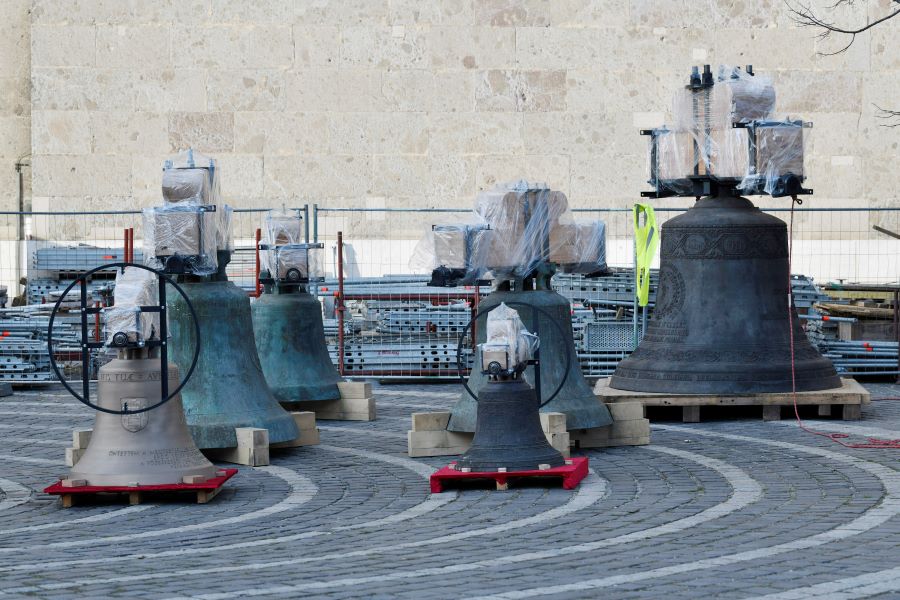
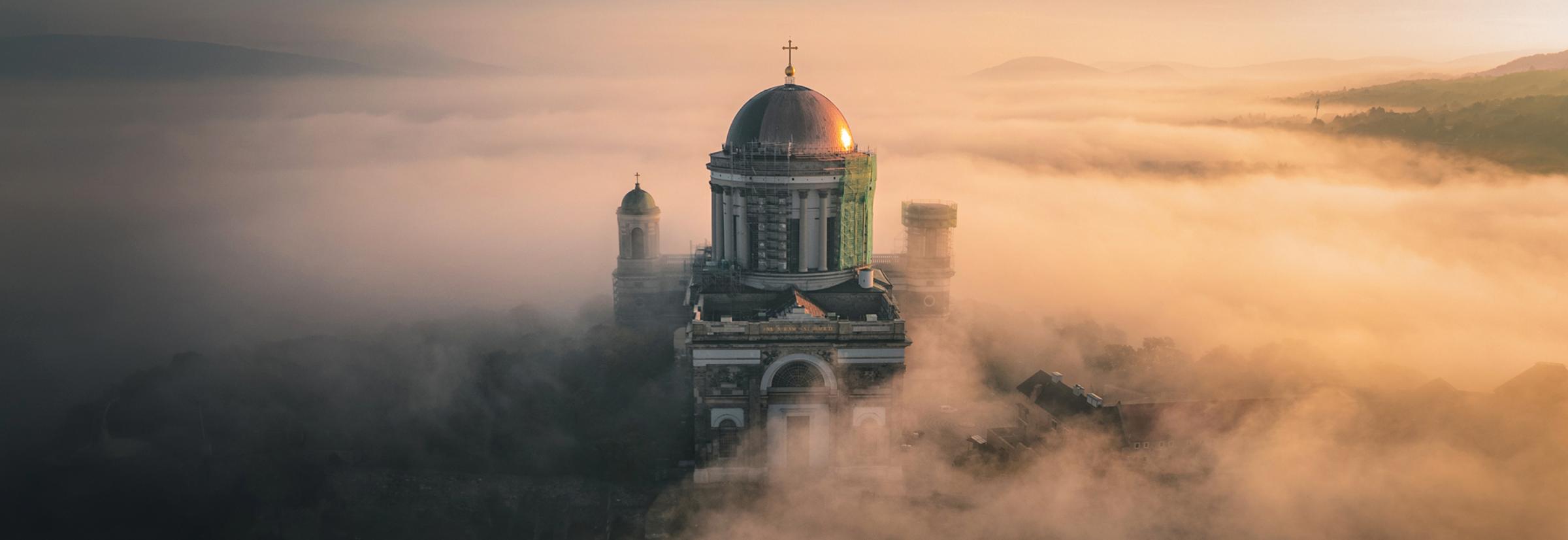

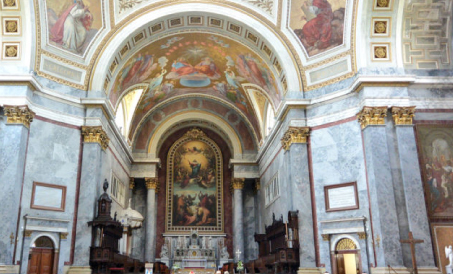
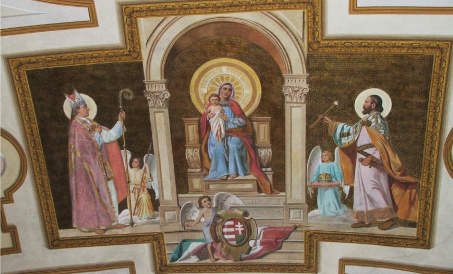
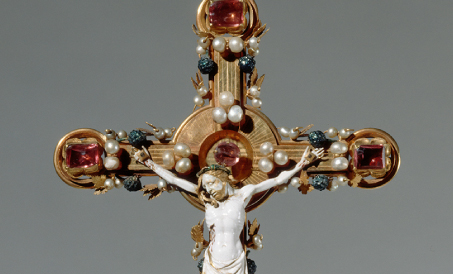
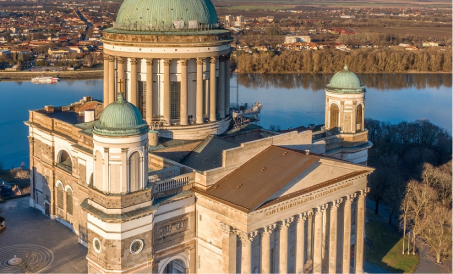
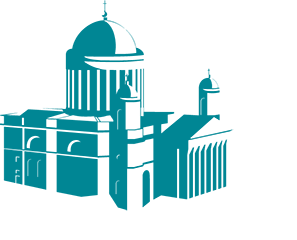
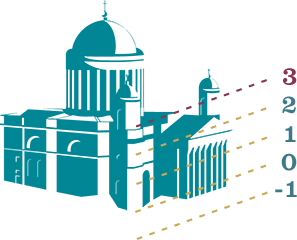

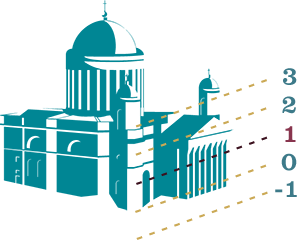
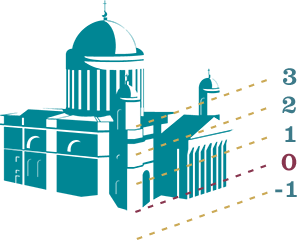
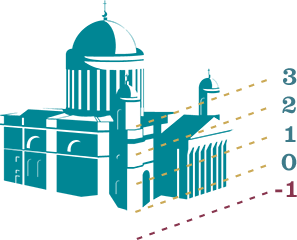

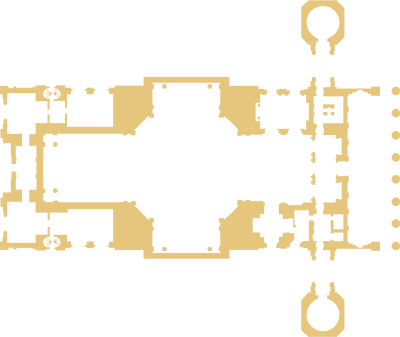






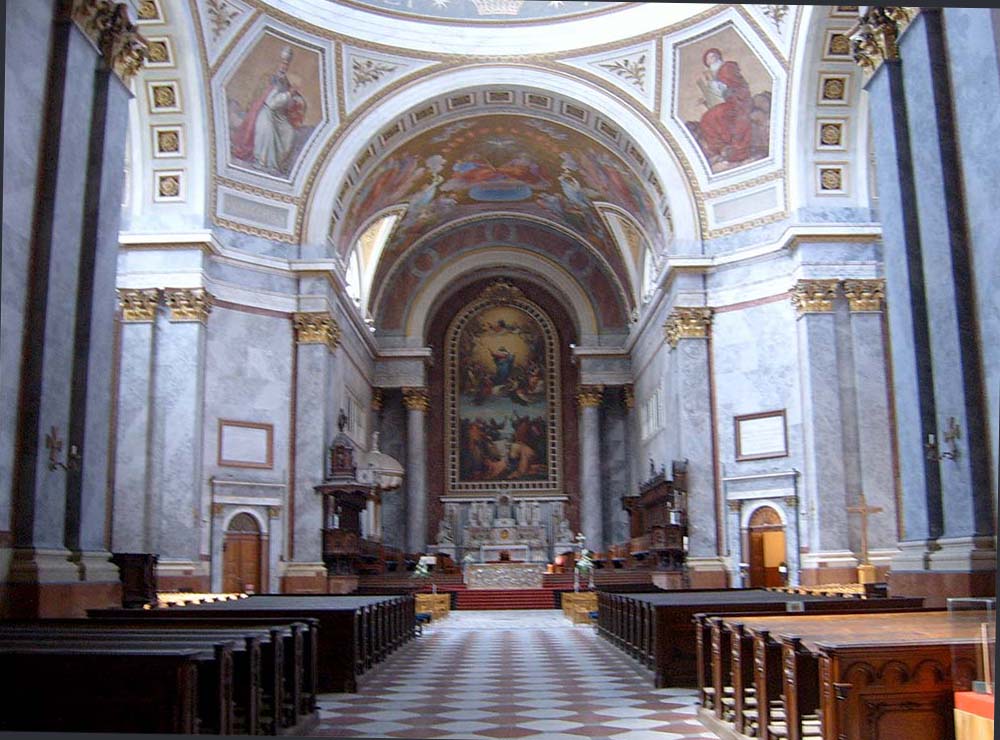












 A great result is the triptych (triple picture) that adorns the wall opposite the entrance. The painting of this picture took about 1 year. A picture frame with thick leaf ornaments encloses the picture and two gilded columns, dividing it into three levels. Each picture is a "room" through whose windows we can see outside. The size of each picture is 250×150 cm.
A great result is the triptych (triple picture) that adorns the wall opposite the entrance. The painting of this picture took about 1 year. A picture frame with thick leaf ornaments encloses the picture and two gilded columns, dividing it into three levels. Each picture is a "room" through whose windows we can see outside. The size of each picture is 250×150 cm.

















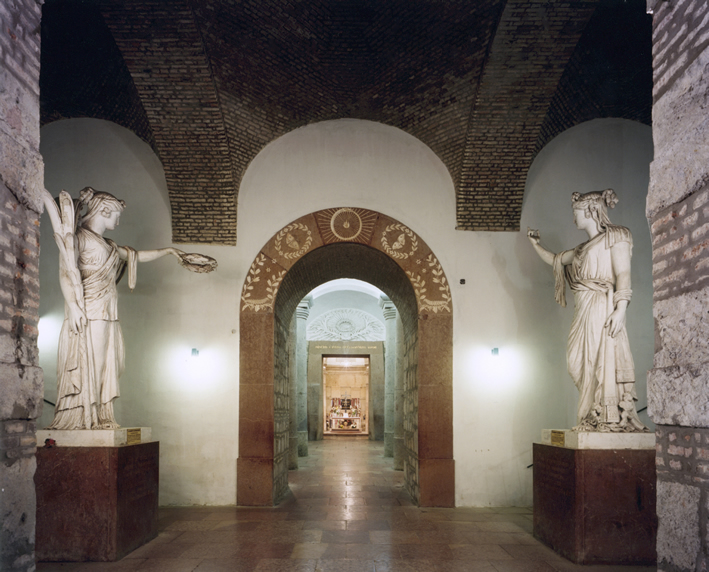


 .
.

